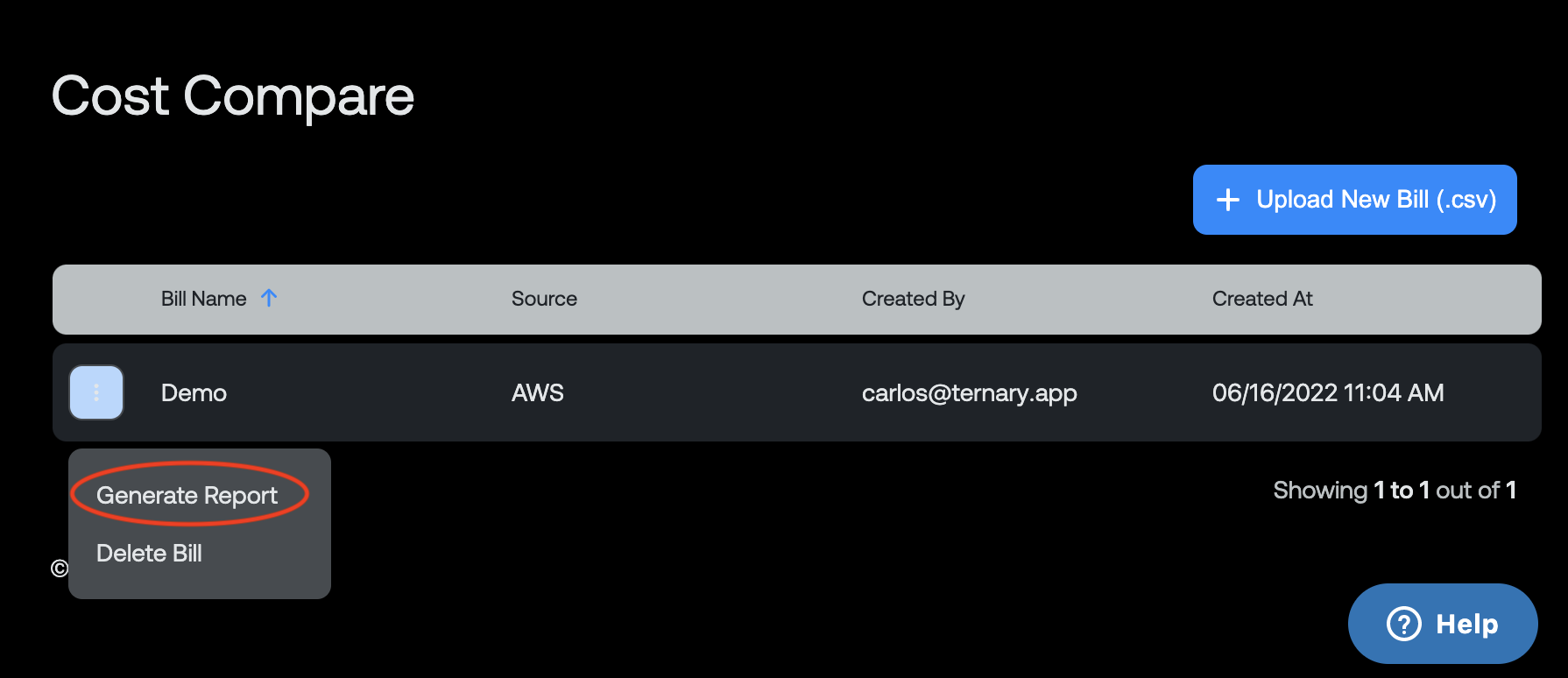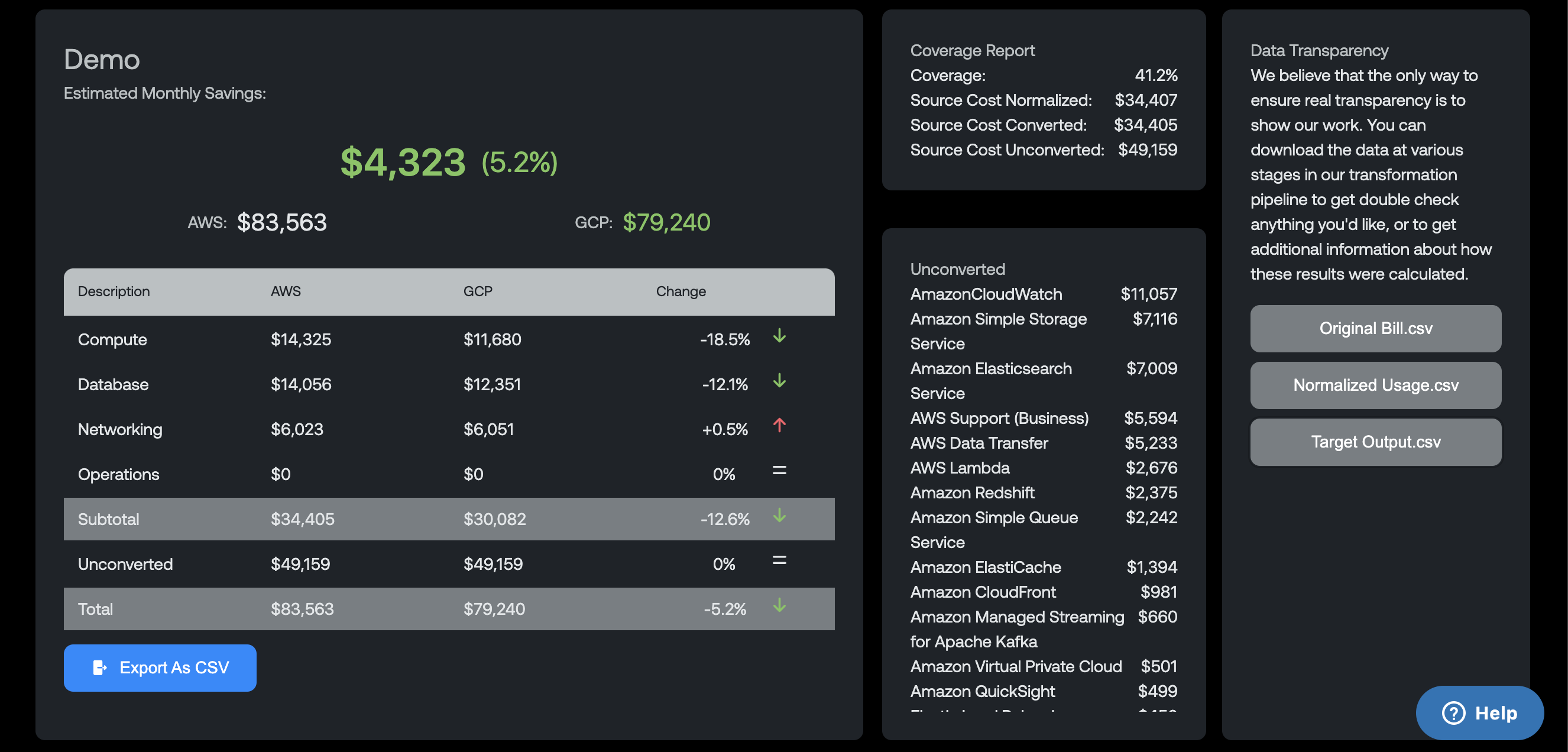How to compare AWS and GCP costs
Requirements
To set up Cost Compare in Ternary, please:
- Speak with your Sales or Customer Success team to enable this feature in your tenant.
- Download a CSV copy of your AWS bill (as described in this user guide).
Usage
-
Upload the bill CSV and set a meaningful display name.

-
Generate a Cost Compare report for the uploaded bill.

Interpretation

The report consists of three sections:
- Cost Comparison Table
This is the primary output of the Cost Comparison report. For the portions of the bill which were converted to the target platform, it displays a side-by-side comparison of cost by category. The categories are also aggregated and displayed as a subtotal of converted costs.
Any costs which were not converted are aggregated into a line item named "Unconverted" and held constant across the platforms as a convenience. - Coverage Report
The coverage report gauges the performance of the Cost Compare tool in comparing the input costs. Higher coverage is ideal.
The percent coverage is determined by the ratio of converted source cost to total source cost, based on the input bill. For example, in an AWS bill with $100k of spend, if the Cost Compare tool can convert $10k of that spend into estimated GCP costs, then the percent coverage will be 10%.
Source Cost Normalized is that portion of spend in the input bill that the Cost Compare tool could parse and represent in Ternary's platform-agnostic model of cloud usage. This is an intermediate step before preceding the application of price data to that platform-agnostic usage.
Source Cost Converted and Source Cost Unconverted are the portions of spend in the input bill which could and could not be converted to the target platform, respectively. By nature, the following will always hold true: (A) the sum of Source Cost Converted and Source Cost Unconverted will equal the total amount in the input bill, and (B) the Source Cost Converted amount will not exceed the Source Cost Normalized amount. - Unconverted Listing
This is a listing of costs in the source bill that could not be converted to the target cloud platform. The costs are aggregated by product names from the source platform.
Constraints
The following are important factors to consider when interpreting the results.
- Savings Instruments - The output estimated costs are based solely on on-demand pricing for the usage amounts observed in the input bill.
Suppose, for example, a user uploads an input AWS bill with usage covered by an All Upfront Savings Plan purchased in an earlier billing period. We expect that this will cause the input invoice total to be advantaged. It will contain line items with non-zero usage but zero-ed costs.
Likewise, suppose a user uploads an input AWS bill with usage covered by a Partial Upfront Reserved Instance purchased in an earlier billing period. The invoice total on the input-side will include some line items with recurring fees associated with the RI, as well as line items with discounted usage.
In both of the above scenarios, the input-side totals are favorably reduced, which can make the output-side totals appear inflated in comparison. It is important to consider how savings instruments can bias the comparison when interpreting the results. - Usage Location - At this time, the output estimated costs are based on pricing for usage located in us-central1. For example, if an input AWS bill includes EC2 usage from a relatively expensive region such as
af-south-1, this will still be converted to GCE usage inus-central1, potentially favoring the output-side cost estimates.
It is important to consider how the absence of location fidelity can impact cost comparisons. - Instance Size Mapping - Cost Compare does not attempt to match predefined instance types across cloud platforms by size. Instead, the input-side usage is mapped to custom machine sizing for the comparison. However, the rough characteristics of the instance family are respected in the mapping (e.g. Compute Optimized, Hardware Accelerated, General Purpose, etc).
It is important to consider how the differences in pricing between predefined and custom compute instances can impact cost comparisons.
Updated 5 months ago
